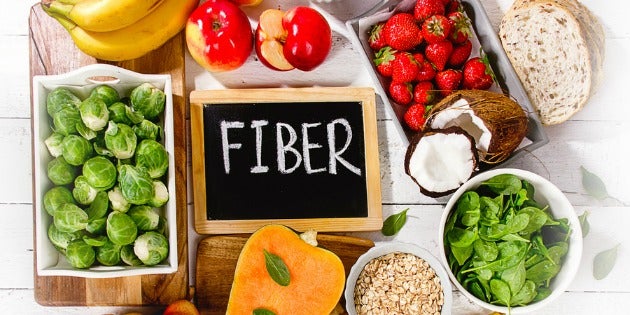Heading out the door? Read this article on the new Outside+ app available now on iOS devices for members! Download the app.

Fiber 101
Fiber is a type of carbohydrate that the body can’t digest, and because of that, it’s vital to your health.
The body relies on a balance of two types of fiber — soluble and insoluble — for proper digestion. Soluble fiber, which dissolves in water, is found in beans, oats, fruits like apples, and some vegetables. Soluble fiber slows digestion, controls blood sugar from spiking, and can help lower “bad” LDL cholesterol to promote a healthy heart. Insoluble fiber, which does not dissolve in water, can help move food through your digestive system. This type has a laxative effect; remember it by thinking INsoluble fiber puts you IN the bathroom (wink, wink!). Boosting of this type of fiber may come in handy to alleviate a bout of constipation, but a moderate amount each day can help with regularity. Good sources of this type of fiber include wheat, brown rice, fruit skins and nuts.
No matter which type of fiber you eat, they both help you feel fuller longer, which is ideal for sustained energy levels and maintaining a healthy weight. There’s actually a third type of fiber, a trendy category of fiber known as functional fiber. Instead of being part of a healthy food, these are isolated fibers that are added to foods to boost the fiber count per serving. These fibers are typically soluble and may possess some of the same health benefits but lack the nutrients that come along with whole foods like grains, legumes and fresh produce. Too much of these supplemental fibers also can lead to stomach upset, so there are numerous reasons to focus on the whole-food sources.
Breaking It Down
Popular questions surrounding fiber include: How much do I need? How much am I currently getting? The recommendation for women is 25 grams per day, which can be difficult to accomplish. In fact, data from the U.S. Department of Agriculture published in 2014 revealed that most women ages 20 to 39 are falling short of their needs, taking in only about 15 grams per day.
Weight Loss
Don’t discount the hunger-fighting superpowers of fiber. Cutting calories is a lot easier if you aren’t starving. Because fiber delays digestion, high-fiber foods help curb appetite for the long haul. Researchers at the Harvard School of Public Health discovered that increasing intake of fiber-rich foods could be used as a tool to fight obesity. The report revealed that women who increased their fiber intake over 12 years were half as likely to become obese as those that decreased their intake.
Digestive Health
The slower digestion rate of fiber also benefits the health of your intestines. As fiber travels through the digestive tract, it’s allowed to ferment in the intestine, promoting healthy bacterial to flourish. The increased amount of healthy bacteria (or improved microbiome, if you want to use the trending terminology) has been linked to improved nutrient absorption and immunity. While this is desirable, people with gastrointestinal conditions or those who just take in too much fiber too quickly may be at risk for stomach discomfort along with other unpleasant tummy troubles. The take-home lesson here is to always increase fiber intake gradually.
Cancer Prevention
Several studies have connected fiber intake with a reduction in cancer risks throughout the body. Research published in the March 2016 issue of the journal Pediatrics found that eating a higher fiber diet in adolescence and early adulthood significantly reduced the risk of developing breast cancer later in life.
The Best Sources of Fiber
Really, the best way to get enough fiber in your diet is through dietary foods because they also offer other nutrients your body needs. If you are eating enough fiber-rich foods, you shouldn’t have to supplement. In fact, many doctors believe some of the health benefits of fiber are attributed to the other vitamins, minerals and antioxidants found in whole-food sources.